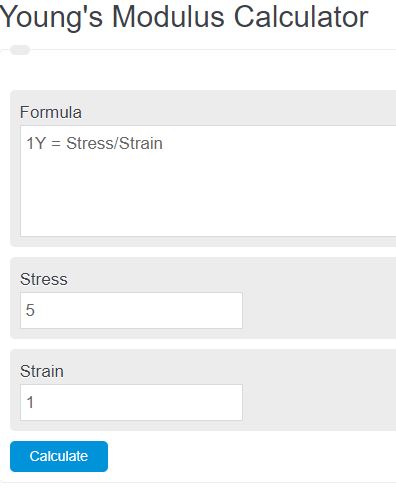Enter the total stress and the strain acting on an object. The calculator will evaluate and display the Young’s modulus of the material.
Young’s Modulus Formula
The following equation can be used to calculate the young’s modulus of a material.
Y = S1 / S2
- Where Y is the Youngs modulus of elasticity
- S1 is the stress
- S2 is the strain
Young’s Modulus Definition
Young’s modulus, also known as the elastic modulus, is a fundamental material property that quantifies the stiffness or rigidity of a solid material. It measures how much a material will deform under an applied force and how well it can return to its original shape once the force is removed.
Young’s modulus is defined as the ratio of stress (force per unit area) to strain (change in length per unit length) within the elastic limit of a material.
It represents the slope of the stress-strain curve in the linear elastic region.
In simpler terms, it describes how much a material stretches or compresses when subjected to a given force.
This material property is crucial in engineering and materials science as it allows engineers to predict and understand how materials will behave under different loads and forces.
By knowing the Young’s modulus of a material, engineers can determine if it will deform or break under specific conditions.
The ability to accurately estimate Young’s modulus is particularly important when designing structures, such as buildings, bridges, and aircraft.
It helps engineers select appropriate materials that can withstand the expected loads without excessively deforming or failing. For example, if a material has a high Young’s modulus, it will be stiffer and less prone to deformation under load, making it suitable for applications where rigidity is a critical factor.
Young’s Modulus Example
How to calculate young’s modulus?
- First, determine the stress.
Measure the total stress acting on the cross-sectional area.
- Next, determine the strain.
Measure the total strain under the stress condition from step 1.
- Finally, calculate the young’s modulus.
Using the formula above, calculate the young’s modulus.
FAQ
What is the significance of Young’s modulus in material science?
Young’s modulus is crucial in material science because it helps in determining the stiffness and elasticity of materials. This property is essential for engineers to understand how materials will respond to applied forces, ensuring the structural integrity of designs.
How is Young’s modulus measured?
Young’s modulus is measured by applying a known force to a material and measuring the resulting deformation. The modulus is then calculated by dividing the stress (force per unit area) by the strain (deformation per unit length).
Can Young’s modulus be negative?
No, Young’s modulus cannot be negative. It is a measure of a material’s stiffness and represents the ratio of stress to strain in the linear elastic region of the material. A negative value would imply that the material produces work or energy under elastic deformation, which violates the laws of thermodynamics.
How does temperature affect Young’s modulus?
Temperature can significantly affect Young’s modulus. Generally, as temperature increases, the modulus decreases because the material becomes more ductile and less stiff. This behavior varies among materials and is critical in applications where materials are exposed to a wide range of temperatures.

